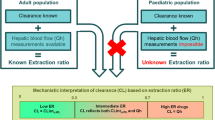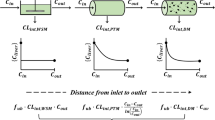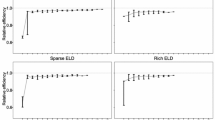Abstract
The axial dispersion model of hepatic drug elimination is characterized by two dimensionless parameters, the dispersion number, DN , and the efficiency number, RN , corresponding to the relative dispersion of material on transit through the organ and the relative efficiency of elimination of drug by the organ, respectively. Optimal design theory was applied to the estimation of these two parameters based on changes in availability (F) of drug at steady state for the closed boundary condition model, with particular attention to variations in the fraction of drug unbound in the perfusate (fuB ). Sensitivity analysis indicates that precision in parameter estimation is greatest when F is low and that correlation between RN and DN is high, which is desirable for parameter estimation, when DN lies between 0.1 and 100. Optimal design points were obtained using D-optimization, taking into account the error variance model. If the error variance model is unknown, it is shown that choosing Poisson error model is reasonable. Furthermore, although not optimal, geometric spacing of fuB values is often reasonable and definitively superior to a uniform spacing strategy. In practice, the range of fuB available for selection may be limited by such practical considerations as assay sensitivity and acceptable concentration range of binding protein. Notwithstanding, optimal design theory provides a rational approach to precise parameter estimation.
Similar content being viewed by others
REFERENCES
D. J. Morgan and R. A. Smallwood. Clinical significance of pharmacokinetic models of hepatic elimination. Clin. Pharmacokin. 18:61–70 (1990).
G. R. Wilkinson. Clearance concepts in pharmacology. Pharmacol. Rev. 39:1–47 (1987).
M. S. Roberts and M. Rowland. A dispersion model of hepatic elimination: 1. Formulation of the model and bolus consideration. J. Pharmacokin. Biopharm. 14:227–260 (1986).
M. S. Roberts and M. Rowland. A dispersion model of hepatic elimination: 2. Steady state considerations—Influence of hepatic blood flow, binding within blood, and hepatocellular enzyme activity. J. Pharmacokin. Biopharm. 14:261–288 (1986).
L. Bass. Models of hepatic drug elimination. J. Pharm. Sci. 72:1229 (1983).
W. A. Colburn. Albumin binding and hepatic uptake: The importance of model selection-A response. J. Pharm. Sci. 72:1233 (1983).
E. L. Forker and B. A. Luxon. Albumin binding and hepatic uptake: The importance of model selection. J. Pharm. Sci. 72:1232–1233 (1983).
D. J. Morgan. Models of hepatic drug elimination: A response. J. Pharm. Sci. 72:1230 (1983).
D. J. Morgan, D. B. Jones, and R. A. Smallwood. Modeling of substrate elimination by the liver: has the albumin receptor model superseded the well-stirred model? Hepatology 5:1231–1235 (1985).
S. Keiding and E. Steiness. Flow dependence of propranolol elimination in perfused rat liver. J. Pharmacol. Exp. Ther. 230:474–477 (1984).
D. B. Jones, D. J. Morgan, G. W. Mihaly, L. K. Webster, and R. A. Smallwood. Discrimination between the venous equilibrium and sinusoidal models of hepatic drug elimination in the isolated perfused rat liver by perturbation of propranolol protein binding. J. Pharmacol. Exp. Ther. 229:522–526 (1984).
D. B. Jones, M. S. Ching, R. A. Smallwood, and D. J. Morgan. A carrier-protein receptor is not a prerequisite for avid hepatic elimination of highly bound compounds: A study of propranolol elimination by the isolated perfused rat liver. Hepatology 5:590–593 (1985).
R. H. Smallwood, G. W. Mihaly, R. A. Smallwood, and D. J. Morgan. Propranolol elimination as described by the venous equilibrium model using flow perturbations in the isolated perfused rat liver. J. Pharm. Sci. 77:330–333 (1988).
J. M. Diaz-Garcia, A. M. Evans, and M. Rowland. Application of the axial dispersion model of hepatic drug elimination to the kinetics of diazepam in the isolated perfused rat liver. J. Pharmacokin. Biopharm. 20:171–193 (1992).
M. S. Ching, D. J. Morgan, and R. A. Smallwood. Models of hepatic elimination: Implications from studies of the simultaneous elimination of taurocholate and diazepam by isolated rat liver under varying conditions of binding. J. Pharmacol. Exp. Ther. 250:1048–1054 (1989).
R. H. Smallwood, D. J. Morgan, G. W. Mihaly, D. B. Jones, and R. A. Smallwood. Effect of plasma protein binding on elimination of taurocholate by isolated perfused rat liver: Comparison of venous equilibrium, undistributed and distributed, sinusoidal and dispersion models. J. Pharmacokin. Biopharm. 16:377–396 (1988).
R. H. Smallwood, D. J. Morgan, G. W. Mihaly, and R. A. Smallwood. Lack of linear correlation between hepatic ligan uptake rate and unbound ligand concentration does not necessarily imply receptor-mediated uptake. J. Pharmacokin. Biopharm. 16:397–412 (1988).
G. E. P. Box, and H. L. Lucas. Design of experiments in non-linear situations. Biometrika 46:77–90 (1959).
A. C. Atkinson and W. G. Hunter. The design of experiments for parameter estimation. Technometrics 10:271–289 (1968).
R. C. St. John and N. R. Draper. D-optimality for regression design. A review. Technometrics 17:15–23 (1975).
D. Z. D'Argenio. Optimal sampling times for pharmacokinetics experiments. J. Pharmacokin. Biopharm. 9:739–755 (1981).
J. J. Distefano III. Design and optimization of tracer experiments in physiology and medicine. Fed. Proc. 39:84–90 (1980).
L. Endrenyi. Design of experiments for estimating enzyme and pharmacokinetic parameters. In L. Endrenyi (ed.), Kinetic Data Analysis: Design and Analysis of Enzyme and Pharmacokinetic Experiments, Plenum Press, New York, 1981, pp. 137–167.
L. Endrenyi and F.-Y. Chan. Optimal design of experiments for the estimation of precise hyperbolic kinetic and binding parameters. J. Theoret. Biol. 90:241–263 (1981).
A. Z. Khan and L. Aarons. Design and analysis of protein binding experiments. J. Theoret. Biol. 140:145–166 (1989).
E. M. Landaw. Optimal design for individual parameter estimation in pharmacokinetics. In M. Rowland, L. B. Sheiner, and J. L. Steiner (eds.), Variability in Drug Therapy: Description, Estimation and Control, Raven Press, New York, 1985, pp. 187–200.
E. D. Morris, M. Saidel, and G. M. Chisolm III. Optimal design of experiments to estimate LDL transport parameters in arterial wall. Am. J. Physiol. 261:H929–H949 (1991).
M. H. Nathanson and G. M. Saidel. Multiple-objective criteria for optimal experimental design: application to ferrokinetics. Am. J. Physiol. 248:R378–R386 (1985).
C. C. Peck, L. B. Sheiner, and A. I. Nichols. The problem of choosing weights in nonlinear regression analysis of pharmacokinetic data. Drug Metab. Rev. 15:133–148 (1984).
Y. Bard. Nonlinear Parameter Estimation, Academic Press, New York, 1974, pp. 258–286.
V. V. Fedorov. Theory of Optimal Experiments, Academic Press, New York, 1972.
M. J. Box. Some experience with a nonlinear experimental design criterion. Technometrics 12:569–589 (1970).
C. M. Metzler, G. L. Elfring, and A. J. McEwea. A User's Manual for NONLIN and Associated Programs, The Upjohn Company, Kalamazoo, MI, 1974.
N. R. Draper and H. Smith. Applied Regressions Analysis, Wiley, New York, 1966.
D. A. Ratowsky, Nonlinear Regression Modeling: A Unified Practical Approach, Marcel Dekker, New York, 1983.
D. J. Pritchard and D. W. Bacon. Prospects for reducing correlations among parameter estimates in kinetic models. Chem. Eng. Sci. 33:1539–1543 (1978).
M. Bezeau and L. Endrenyi. Design of experiments for the precise estimation of dose-response parameters: the Hill equation. J. Theoret. Biol. 123:415–430 (1986).
Z. Hussein, A. M. Evans, and M. Rowland. Physiologic models of hepatic drug clearance. Influence of altered protein binding on the elimination of diclofenac in the isolated perfused rat liver. J. Pharm. Sci. 82:880–885 (1993).
Author information
Authors and Affiliations
Rights and permissions
About this article
Cite this article
Chou, CH., Aarons, L. & Rowland, M. Optimal Experimental Design for Precise Estimation of the Parameters of the Axial Dispersion Model of Hepatic Elimination. J Pharmacokinet Pharmacodyn 26, 595–615 (1998). https://doi.org/10.1023/A:1023229318017
Published:
Issue Date:
DOI: https://doi.org/10.1023/A:1023229318017




